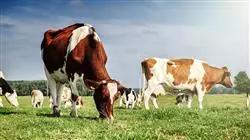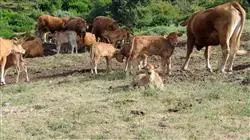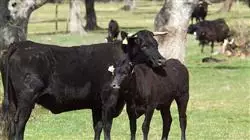University certificate
The world's largest faculty of veterinary medicine”
Description
We offer you the most comprehensive program on the market to bring Extensive Livestock Management to the same level as clinical and sanitary practice, offering your clients the highest quality in both services"

The Postgraduate diploma in Economics and Genetic Resources of Beef and Lidia Cattle in Extensive Farming Systems has a comprehensive program that covers the broadest spectrum of species and breeds used in Animal Production in Extensive Farming Systems. Not only is in-depth and specialized attention paid to the most common productions, but also to other much less common but highly relevant productions, which demand a greater degree of specialization from professionals in the area.
Likewise, the level of knowledge and professional experience of the professors of the program allows them to deal with very specific productions, where it is very difficult to access levels of specialization, except for the small number of people who have had the opportunity to develop their knowledge within the scope of this type of livestock farming.
This program is the most specialized since the development of each subject is structured according to the knowledge and experience of the teaching team, avoiding generalist voluntarism which, although it can provide acceptable global visions, lacks the capacity to study in depth each and every one of the subjects that need to be addressed with the highest quality.
The high levels of knowledge provided by the faculty in the areas of economics, genetics and animal breeding contribute decisively to consolidate and expand knowledge in two areas that are absolutely fundamental to achieve success in the management of extensive livestock production.
Immerse yourself in this high quality educational training, which will allow you to face the future challenges of Economics and Genetic Resources of Beef and Lidia Cattle in Extensive Farming Systems"
This Postgraduate diploma in Economics and Genetic Resources of Beef and Lidia Cattle in Extensive Farming Systems contains the most complete and up-to-date scientific program on the market. The most important features include:
- The development of case studies presented by experts in the management of veterinary centers
- The graphic, schematic, and practical contents with which they are created, provide scientific and practical information on the disciplines that are essential for professional practice
- New developments on Lidia Beef and Cattle Economics and Genetic Resources in Extensive Farming Systems
- Practical exercises where self-assessment can be used to improve learning
- Special focus on innovative methodologies in Lidia Beef and Cattle Economics and Genetic Resources in Extensive Farming Systems
- Theoretical lessons, questions to the expert, debate forums on controversial topics, and individual reflection assignments
- Content that is accessible from any fixed or portable device with an Internet connection
This Postgraduate diploma is the best investment you can make in selecting an up-to-date program to upgrade your knowledge in Economics and Genetic Resources of Beef and Lidia Cattle in Extensive Farming Systems”
It includes in its teaching staff, professionals belonging to the field of extensive livestock farming, who contribute to this training the experience of their work, in addition to recognized specialists from leading societies and prestigious universities.
The multimedia content, developed with the latest educational technology, will provide the professional with situated and contextual learning, i.e., a simulated environment that will provide immersive education programmed to learn in real situations.
This program is designed around Problem-Based Learning, whereby the specialist must try to solve the different professional practice situations that arise throughout the program. To do so, the professional will be assisted by an innovative interactive video system created by recognized experts in Extensive Livestock Management.
This program comes with the best educational material, providing you with a contextual approach that will facilitate your learning"

This 100% online Postgraduate diploma will allow you to balance your studies with your professional work while expanding your knowledge in this field"
Syllabus
With a structure and content designed by specialists in the subject of study, this Postgraduate diploma aims to provide the graduate with the most specific knowledge about New Technologies and Gamification in Geography and History in Primary Education. There will be 450 hours of study organized at the student's convenience, according to his or her own schedule, with no restrictions. You will have a series of detailed videos, research articles, further reading, images, diagrams and much more. All accessible from your favorite device with internet connection, a convenient and cutting-edge way to study.

This program contains the most important news about Technologies and Gamification for the teaching of Geography and History in Primary School"
Module 1. Economic Aspects Related to Extensive Livestock Farming
1.1. Economics of Extensive Livestock Farming
1.1.1 The Breeding Factors; their Relationship and Importance; the SAFFE
1.1.1.1. Introduction
1.1.1.2. The Basis of SAFEE
1.1.1.3. SAFEE Objectives
1.1.1.4. Initial Conclusions
1.1.1.5. Second Conclusions
1.1.1.6. Third Conclusions
1.1.1.7. Fourth Conclusions
1.2. The Basis of Your Business Finances
1.2.1. Introduction
1.2.2. Accounting and its Types
1.2.3. Control and Development of Accounting Models
1.2.4. The Main Accounting Principles
1.2.5. Finance
1.2.6. Treasury
1.2.7. The Balance Sheet
1.3. Income Statement and Economic Flows
1.3.1. Introduction
1.3.2. Results Research
1.3.3. Economic and Financial Cash Flows
1.3.4. The Added Value
1.3.5. Initial Conclusions
1.4. Equity and Financial Analysis of Livestock Production
1.4.1. Introduction
1.4.2. Operation of the Financial Accounts
1.4.3. Equity Accounts
1.4.4. Difference Accounts
1.4.5. Profit and Loss Accounts
1.4.6. Checks
1.4.7. Arrangement of the Balance Sheet
1.4.8. Analysis of the Development of the Balance Sheet
1.4.9. Initial Conclusions
1.5. The Main Ratios to be Considered in Extensive Livestock Farming I
1.5.1. Introduction
1.5.2. The Relative Value of Ratios
1.5.3. Types of Ratios
1.5.4. Ratios to Evaluate Profitability
1.5.5. Ratios to Evaluate Liquidity
1.5.6. Debt Diagnosis Ratios
1.6. The Main Ratios to be Considered in Extensive Livestock Farming II
1.6.1. Introduction
1.6.2. Ratios for Diagnosing Asset Turnover
1.6.3. Collection Management Ratios
1.6.4. Payment Management Ratios
1.6.5. Other Ratios of Interest
1.6.6. Initial Conclusions
1.7. Bases of Livestock Economic Analysis
1.7.1. Introduction
1.7.2. Percentage Valuation
1.7.3. Analysis of Commercial Actions
1.7.4. Analysis of Expenses
1.7.5. Productivity Analysis
1.7.6. Analysis of Efficacy
1.7.7. Initial Conclusions
1.8. The Problem of Financing Extensive Livestock Farming
1.8.1. Introduction
1.8.2. Interest from Financing Sources
1.8.3. The Debt Policy and its Costs
1.8.4. The Structure of Indebtedness
1.8.5. Sources of Indebtedness
1.8.6. Self-financing
1.8.7. Initial Conclusions
1.9. Economic Planning in Extensive Livestock Farming I
1.9.1. The Budget
1.9.2. The Cash Budget
1.9.3. Budget Execution
1.9.4. The Flexible Budget
1.10. Economic Planning in Extensive Livestock Farming II
1.10.1. Analysis of Budget Deviations
1.10.2. The Interim Income Statement
1.10.3. Provisional Balance Sheet
1.10.4. Conclusions
Module 2. Genetic Resources of Extensive Populations and Programs for Improvement and Promotion of the Different Breeds
2.1. Relevance of Biodiversity in the Sustainable Development of the Planet
2.1.1. Biodiversity Concept
2.1.2. Importance of Biodiversity Conservation
2.1.3. Threats to the Maintenance of Biodiversity
2.2. Measurement of Genetic Diversity
2.2.1. Genetic Diversity
2.2.2. Consequences of the Loss of Genetic Diversity: Inbreeding
2.2.3. Molecular Tools for Measuring Diversity
2.2.4. Measures of Genetic Diversity
2.2.5. Genetics and Extinction
2.3. Animal Genetic Resources: Current Situation
2.3.1. Concept of Animal Genetic Resources
2.3.2. Distribution of Animal Genetic Resources at the Global Level
2.3.3. Distribution of Animal Genetic Resources by Domestic Species
2.3.4. Current Trends in Gene Flows
2.4. Methods of Conservation of Animal Genetic Resources
2.4.1. Inventory of Animal Genetic Resources
2.4.2. Conservation in situ
2.4.3. Conservation ex situ
2.5. Contribution of Native Breeds and the Extensive Farming System to the Maintenance of Biodiversity
2.5.1. Livestock and Landscape
2.5.2. Adaptation of Populations to the Environment
2.5.3. Conservation of Extensive Ecosystems
2.5.4. Livestock Utilization and Fire Prevention
2.6. Population Conservation Programs: Endangered Breeds
2.6.1. Justification for the Existence of Population Conservation Programs Socioeconomic Implications. Sustainable Development
2.6.2. Population Conservation Objectives
2.6.3. Stock Conservation Criteria
2.6.4. Methodology Used in the Conservation of Stocks
2.6.5. Forecast of Genetic Resources to be Utilized and Future Population Trends
2.7. Stock Enhancement Programs: Beef Cattle
2.7.1. Selection Objectives
2.7.2. Selection Criteria
2.7.3. Individual Identification and Parentage Control
2.7.4. Yield Control
2.7.5. Genetic Assessments
2.7.6. Testing of Breeding Candidates
2.7.7. Dissemination of the Improvement
2.8. Population Improvement Programs: Small Ruminants
2.8.1. Selection Objectives
2.8.2. Selection Criteria
2.8.3. Individual Identification and Parentage Control
2.8.4. Yield Control
2.8.5. Genetic Assessments
2.8.6. Testing of Breeding Candidates
2.8.7. Dissemination of the Improvement
2.9. Stock Improvement Programs: Extensive Pig Farming
2.9.1. Selection Objectives
2.9.2. Selection Criteria
2.9.3. Individual Identification and Parentage Control
2.9.4. Yield Control
2.9.5. Genetic Assessments
2.9.6. Testing of Breeding Candidates
2.9.7. Dissemination of the Improvement
2.10. Population Conservation Programs: Other Species
2.10.1. Conservation Programs for Game Species
2.10.2. Conservation Programs for Other Species of Ecological Interest
Module 3. Lidia Cattle Production
3.1. Prototypes and Breed Base of the Lidia Cattle I
3.1.1. Origins of the Lidia Bull
3.1.2. The Bravery of the Bull and its Manifestations
3.1.3. Coats and Horns of the Lidia Cattle
3.1.4. Foundational Castes
3.1.5. Breeds derived from the Vistahermosa I Breed
3.2. Prototypes and Breed Base of the Lidia Cattle II
3.2.1. Breeds derived from the Vistahermosa II Breed
3.2.2. Crossbreeding with the Vistahermosa Breed
3.2.3. The Lidia Breed in Portugal
3.2.4. The Lidia Breed in France
3.2.5. The Lidia Breed in Mexico
3.2.6. The Lidia Breed in Colombia
3.2.7. The Lidia Breed in Ecuador
3.2.8. The Lidia Breed in Venezuela
3.2.9. The Lidia Breed in Peru
3.3. Herd Book of the Lidia Cattle Breed
3.3.1. Historical Precedents
3.3.2. The 1990 Regulations
3.3.3. The 2013 Regulations
3.4. Selection in the Lidia Breed
3.4.1. General Aspects of Selection in the Lidia Breed
3.4.2. Morphological Selection
3.4.3. Genealogical Selection
3.4.4. Functional and Behavioral Selection. The Temptation and its Results
3.4.5. Other Selection Methods
3.4.6. Selection Pressure
3.4.7. Proof of Offspring
3.4.8. Pardon as a Method of Selection
3.4.9. The Breeding Program for the Lidia Breed
3.5. Breeding and Production Cycles of the Lida Cattle
3.5.1. Coverage
3.5.2. Birth and Lactation
3.5.3. The Unborn and Weaning
3.5.4. The Horseshoe Mill
3.5.5. Rebreeding
3.5.6. The Selection of Breeders
3.5.7. Handling, Stowage and Shipments
3.5.8. Recognition in the Bullring
3.6. The Feeding of Lidia Cattle
3.6.1. General Dietary Guidelines
3.6.2. The Feeding of Breeding Cows
3.6.3. Stallion Feeding
3.6.4. Heifer Feeding
3.6.5. Yearling Feeding
3.6.6. Feeding of Erales (Young Bulls)
3.6.7. Feeding of Foals
3.6.8. Feeding of Bulls
3.7. Most Frequent Pathologies in Lidia Cattle
3.7.1. Infectious Pathologies
3.7.2. Parasitic Pathologies
3.7.3. Nutrition-Related Pathologies
3.7.4. Pathologies Related to the Breeding and Management of Lidia Cattle
3.7.5. Injuries Produced During Bullfighting and their Treatment in Pardoned Bulls
3.8. Management and Facilities for Lidia Cattle Breeding
3.8.1. Handling Facilities in Lidia Cattle Farming
3.8.2. Management of Breeding Cows
3.8.3. Stallion Management
3.8.4. Management of Rebreeding Heifers
3.8.5. Management of Males from Yearlings to Bulls
3.8.6. Halters, Dogs and Other Elements Used in the Handling of Fighting Bulls
3.9. Assisted Reproduction in Fighting Livestock
3.9.1. Peculiarities of Assisted Reproduction in the Lidia Cattle
3.9.2. Techniques for Semen Collection and Preservation
3.9.3. Artificial Insemination
3.9.4. Techniques for Oocyte Retrieval and Preservation
3.9.5. Embryo Procurement, Conservation and Transfer Techniques
3.9.6. The Market for Genetics in the Cattle Breeding Industry
3.10. Economics of the Cattle Breeding Farm
3.10.1. The Current Lidia Bull Market
3.10.2. Income and Expenses of Lidia Cattle Farming
3.10.3. Production Costs
3.10.4. Income from Sales and Subsidies
3.10.5. Rural Tourism as a Complementary Income
3.10.6. The Profitability of the Farms in the Bullfighting Industry
3.10.7. Current Situation and Economic Prospects of the Lidia Cattle Breeding Industry
Module 4. Extensive Beef Cattle Production
4.1. Racial Basis of Extensive Beef Cattle Production I
4.1.1. Beef Cattle Morphology
4.1.2. Production and Adaptation to the Environment
4.1.3. Indigenous Breeds Specialized in Meat Production
4.1.4. Endangered Native Breeds Specialized in Meat Production
4.2. Racial Basis of Extensive Beef Cattle Production II
4.2.1. Mixed Breeds Specialized in Meat Production
4.2.2. Main European, American and Asian Breeds Specialized in Meat Production
4.2.3. Cebuinos and Hybrids
4.2.4. Buffalo
4.2.5. Bison
4.3. Yield Control and Data Collection Systems
4.3.1. Individual Morphological, Productive and Reproductive Data (Study Variables)
4.3.2. External and Internal Influencing Factors
4.3.3. Methodologies for Data Collection and Analysis
4.4. Extensive Beef Cattle Production Systems and Handling Facilities
4.4.1. Grazing in Beef Cattle
4.4.2. The Pasture
4.4.3. Grazing in Mountain Areas
4.4.4. Grazing in Other Rainfed Areas
4.4.5. Grazing on Irrigated Farms and in Marsh Areas
4.4.6. Dietary Supplementation in Extensive Beef Cattle Production Systems
4.4.7. Rearing and Handling Facilities for Beef Cattle Farmed in Extensive Systems
4.5. Beef Cattle Feeding in Extensive Farming:
4.5.1. General Feeding Guidelines for Cattle in Extensive Production
4.5.2. Cow Feeding in Different Ecosystems
4.5.3. Stallion Feeding
4.5.4. Feeding of Replacement Heifers
4.5.5. Feeding of Beef Calves in Extensive Systems
4.6. Most Frequent Pathologies in Beef Cattle Farmed in Extensive Systems
4.6.1. Pathologies of Infectious Origin
4.6.2. Pathologies of Parasitic Origin
4.6.3. Pathologies of Metabolic Origin
4.6.4. Reproductive Pathologies
4.6.5. Pathologies Related to Handling
4.7. Reproductive Management of Beef Cattle Farms
4.7.1. Reproductive Systems Used in Extensively Farmed Beef Cattle
4.7.2. Reproductive Management of Cows
4.7.3. Reproductive Management of Stallions
4.7.4. Reproductive Management of Heifers
4.8. Organoleptic Characteristics and Meat Quality in Beef Produced in Extensive Systems. Beef Production for PGI and PDO. Organic Production
4.8.1. Organoleptic Characteristics and Meat Quality of Beef from Cattle Produced in Extensive Systems
4.8.2. Protected Geographical Indications in Beef Cattle
4.8.3. Beef Cattle Protected Denominations of Origin
4.8.4. Organic Beef Cattle Production
4.9. Production of Beef and Other Red Meat in Extensive Systems. Wagyu Beef Production. Lidia Meat. Buffalo Meat. Bison Meat
4.9.1. Beef Production in Extensive Beef Systems
4.9.2. Beef Production in Extensive Systems
4.9.3. Wagyu and Kobe Beef Production
4.9.4. Lidia Beef
4.9.5. Buffalo Meat
4.9.6. Bison Meat
4.10. Economic Aspects of Beef Cattle Production in Extensive Systems
4.10.1. Income and Expenses of Extensive Beef Cattle Farms
4.10.2. Main Factors Affecting Farm Profitability
4.10.3. The Extensive Beef Cattle Market
4.10.4. Current Situation and Future Prospects

This training will allow you to seamlessly advance in your career"
Postgraduate Diploma in Economics and Genetic Resources of Beef and Lidia Cattle in Extensive Farming Systems
At TECH Global University, we invite you to immerse yourself in the exciting world of the Postgraduate Diploma in Economics and Genetic Resources of Beef and Lidia Cattle in Extensive Farming Systems through our Postgraduate Diploma. Discover the opportunities offered by our online classes and expand your knowledge in this field of great relevance and potential. Our program will give you access to the best online classes, taught by experts in the field. You will learn about the latest research and advances in the economics and management of genetic resources in the field of extensive beef and dairy cattle. You'll get a solid, up-to-date education that will open doors in the industry and provide opportunities for professional development. Online classes offer numerous benefits that you can't ignore. You will be able to access them from anywhere and at any time, adapting them to your schedules and needs. In addition, you will have interactive resources, quality teaching materials and the possibility of interacting with teachers and other participants, which will enrich your learning and allow you to establish professional contacts.
The best benefits of a 100% online education
At TECH Global University, we are proud to offer you a quality methodology that adapts to your needs. Our practical and results-oriented approach will provide you with the tools you need to understand and analyze the economics and genetic resources of beef and beef cattle in extensive farming systems. You will be able to apply your knowledge in real-life situations and develop efficient economic and genetic strategies. Upon successful completion of the Postgraduate Diploma, you will receive a recognized certificate that will support your competencies and distinguish you in the labor field. You will be able to work in livestock companies, agricultural consultancies, government agencies and other sectors related to the economics and genetic resources of beef and lidia cattle breeding in extensive farming systems.







